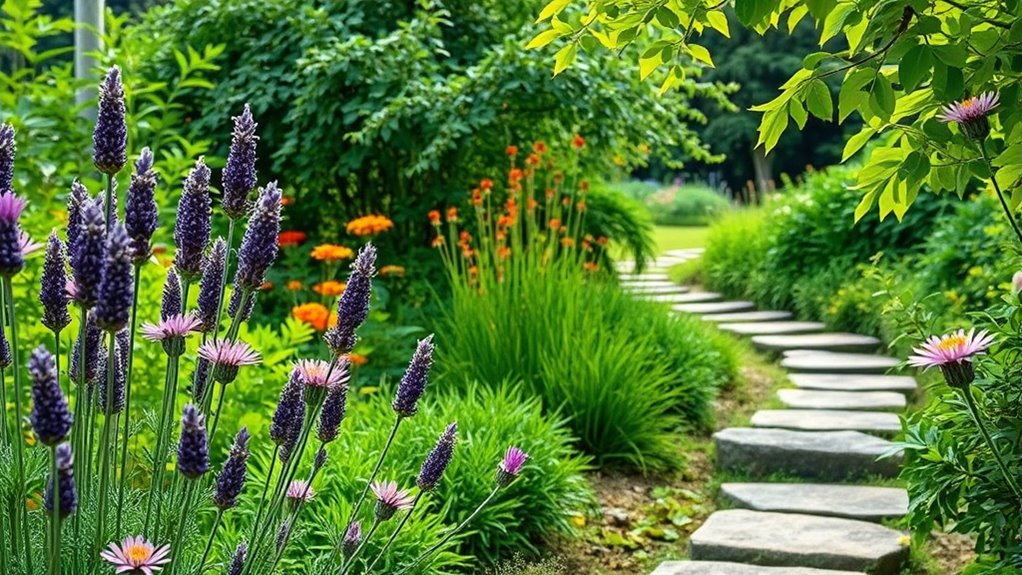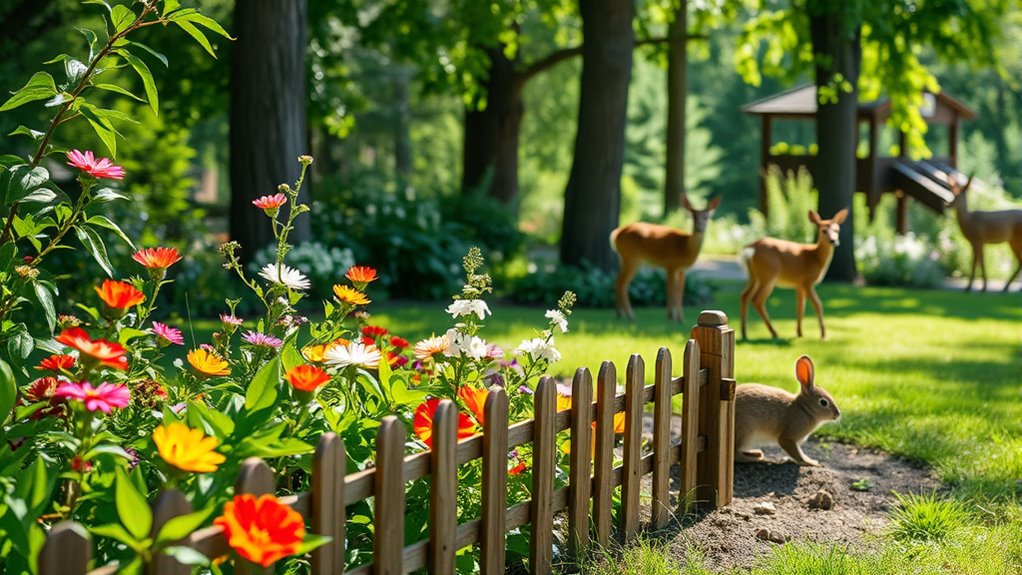To keep deer and rabbits away naturally, you can use homemade repellents like garlic and hot pepper sprays, combined with physical barriers such as tall fences and dense plantings with sharp or strong-smelling foliage. Adding visual deterrents like shiny or moving objects also helps, especially when you change them regularly. Regularly inspecting and maintaining these methods, plus removing attractants, can create an effective, eco-friendly defense. If you want to learn more about these strategies, keep exploring practical solutions.
Key Takeaways
- Use garlic and hot pepper spray regularly to create unpleasant smells and tastes that deter deer and rabbits.
- Install tall fences (at least 8 feet) for deer and small-mesh fences (2-3 feet) for rabbits to physically block access.
- Incorporate reflective or moving visual deterrents, changing methods periodically to prevent animals from ignoring them.
- Rotate natural repellents and adjust barriers periodically to maintain their effectiveness and confuse pests.
- Remove attractants and plant deterrent species with sharp or strong-smelling foliage to discourage visits.

Ever wondered how to protect your garden from pesky deer and rabbits without resorting to chemicals? The good news is, you can keep these critters at bay using natural repellents and smart plant barriers. Instead of relying on sprays filled with chemicals, which can harm your plants and the environment, you can create an effective defense system that’s both safe and sustainable.
Start by understanding that deer and rabbits are primarily after your tender, nutritious plants. To deter them, you need to make your garden less appealing. Natural repellents are a great way to do this—they often come from ingredients you already have in your kitchen or garden. For example, a mixture of garlic and hot pepper spray can create an unpleasant smell and taste that deer and rabbits want to avoid. Simply blend garlic, chili peppers, and water, then strain and spray it on your plants regularly. The strong scent confuses and discourages these animals from munching on your garden. Another option is using commercially available natural repellents made from predator urine or plant-based ingredients. These often work by mimicking the presence of predators, triggering the animals’ flight response.
In addition to repellents, plant barriers are a highly effective method to keep unwanted visitors out. Think of fences, netting, or even dense plantings that create physical obstacles. A fence that’s at least 8 feet tall effectively blocks deer from jumping over, while rabbit-proof fencing is typically around 2 to 3 feet tall with a mesh size small enough to prevent rabbits from slipping through. You can also plant certain species around your garden, like holly, barberry, or lavender, which act as natural barriers. These plants have sharp or strong-smelling foliage that deer and rabbits tend to avoid. When combined, natural repellents and plant barriers create a layered defense, making your garden less inviting to these animals.
Additionally, understanding the importance of contrast ratio in visual deterrents can help you design more effective physical barriers, such as reflective or moving objects that startle animals. It’s also helpful to change your methods periodically. Animals quickly learn to ignore repeated deterrents, so rotating different repellents or adjusting your barriers keeps them guessing. Remember, consistency is key. Regularly inspecting your garden and maintaining these defenses will ensure your plants stay protected. With a little effort, you can enjoy a lush, thriving garden without worrying about deer and rabbits destroying your hard work. Using natural repellents and strategic plant barriers not only keeps your garden safe but also preserves the natural balance of your outdoor space.
Frequently Asked Questions
Do Natural Repellents Harm Beneficial Insects?
Natural repellents generally prioritize beneficial insect safety, making them a better choice than chemical pesticides. They tend to target specific pests like deer or rabbits without harming pollinators or other helpful insects. You should still check ingredients, as some blends may cause pesticide concerns if overly concentrated or improperly applied. Overall, natural repellents offer a safer approach to pest control that minimizes harm to beneficial insects, supporting a healthy garden ecosystem.
How Long Do Natural Deer and Rabbit Deterrents Last?
You might wonder how long natural deer and rabbit deterrents last. Their duration effectiveness depends on environmental factors like rain, wind, and sunlight, which can wash away or degrade repellents quickly. Typically, you can expect their effectiveness to last from a few days to a couple of weeks. To maintain a barrier, reapply after heavy rain or every week, ensuring your garden stays protected naturally.
Can I Use Natural Methods Around Edible Plants Safely?
You can safely use natural methods around edible plants by practicing companion planting and organic pest control. Companion planting attracts beneficial insects and repels pests naturally, protecting your crops without chemicals. Organic pest control methods, like neem oil or garlic spray, are safe for edible plants and your family. Just guarantee you follow application instructions closely, and avoid using harsh substances that could harm your plants or soil health.
Are There Specific Plants That Naturally Repel Deer and Rabbits?
Did you know that over 70% of gardeners struggle with deer and rabbits? You can combat this by planting deer resistant plants and rabbit repellent flora. Some popular choices include lavender, marigolds, and daffodils, which naturally deter these animals. Incorporating these plants into your garden creates a natural barrier, making it less appealing for deer and rabbits without harmful chemicals. This way, your edible plants stay safe and protected.
How Effective Are Homemade Repellents Compared to Commercial Products?
You might wonder how DIY solutions stack up against commercial effectiveness. While homemade repellents use natural ingredients like garlic or chili, their effectiveness varies and may need frequent reapplication. Commercial products are often formulated for longer-lasting results and consistency. However, DIY options can be cost-effective and environmentally friendly, making them a good first step. Overall, combining both approaches can offer the best protection for your garden.
Conclusion
So, next time you find your veggies nibbled or your flowers trampled, remember that nature often has a surprising way of helping out. Sometimes, a simple scent or barrier you set up can turn those unwelcome guests away—just like it did for a neighbor’s garden right when she was about to give up. It’s funny how solutions can appear when you least expect them, turning your garden into a peaceful haven once again.









